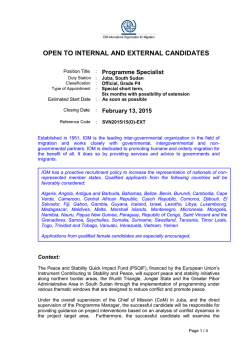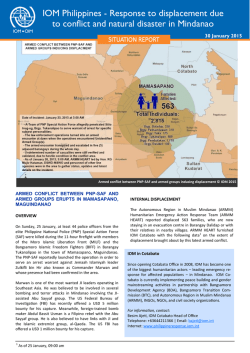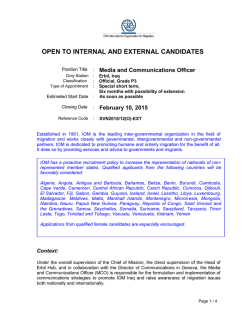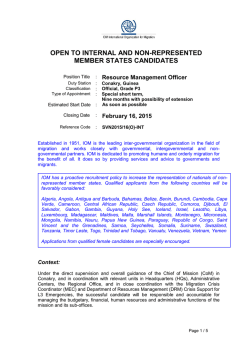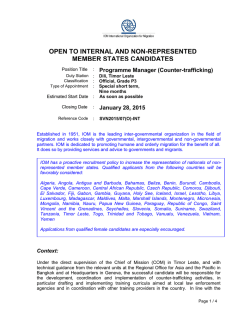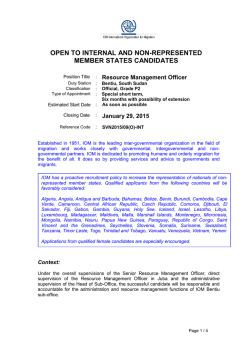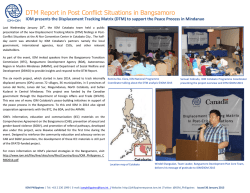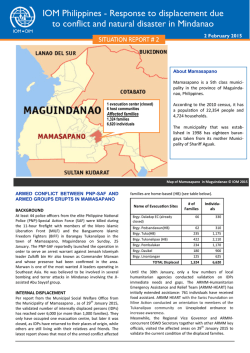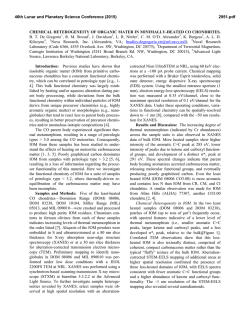
europe / mediterranean migration response
EUROPE / MEDITERRANEAN MIGRATION RESPONSE INTERNATIONAL ORGANIZATION FOR MIGRATION SITUATION REPORT 12 November 2015 Highlights IOM team conducted the DTM survey in Arabic at the Opatovac transit centre © IOM Croatia, 2015 IOM teams present in Greece, IOM has provided the reception the former Yugoslav Republic of Macedonia and Serbia continue to gather and process data on the migration flows along the routes and border points and distribute information to relevant stakeholders, including government authorities. centre in Gevgelija with an additional 12 data entry clerks who are assisting authorities in the registration of migrants and refugees. In Croatia, as part of IOM’s effort to provide emergency shelter for the upcoming winter season, IOM has procured and delivered 20 containers for the new centre along with 20 heaters for the containers. These containers will host the most vulnerable migrants and refugees during their stay at the transit centre. CONTACTS: In Serbia, since 1 September, IOM has transported over 42,000 people from the border crossing to the registration centre in Presevo. IOM has organized transport assistance for 25 migrants in Niger returning to Senegal (12), Guinea Bissau (2), Guinea Conakry (4), Cameroon (1), Sierra Leone (3), and Liberia (3). Preparedness and Response Division [email protected] Donor Relations Division +41.22.7179.271 [email protected] http://www.iom.int Between 1 January and 10 November, IOM together with its partners and through its legal roving teams in Sicily, Calabria and Apulia, has assisted with more than 390 boat landings by being present at the port of arrivals and providing assistance and legal counselling to approximately 95% of the migrants arriving by sea, both at landing points and at the first reception centres. IOM distributed 340 non-food item (NFI) kits that included mattresses, pillows and blankets, and 340 hygiene kits to migrants rescued at sea at the Suq Al-Ahad centre in Tripoli, Libya. EUROPE / MEDITERRANEAN MIGRATION RESPONSE IOM Response Situation Report | 12 November 2015 SITUATION OVERVIEW As of 11 November, an estimated total of 805,828 arrivals by sea have been reported, with Italy (141,766) and Greece (660,111) receiving the majority of the numbers since the start of the year. Total deaths are estimated to be at 3,455. averaged approximately 6,600 per day. In addition to the registration centre in Preševo, the government has identified a building in Bujanovac to serve as an additional registration centre to assist with the high registration numbers happening at Preševo. According to the Ministry of the Interior, a total of 354,446 migrants and refugees have entered into Croatia from 16 September to 10 November. On 6 and 7 November, numbers were smaller than usual due to a strike by the Greek ferry operators, where daily arrivals only reached 2,100 and 2,000 respectively. By 8 November, the flow of migrants and refugees picked up again with approximately 5,500 arrivals. Migrants rescued at sea by Italian coast guards © IOM Rome, 2015 While the Opatovac transit centre in Croatia remained operational until 4 November, reception and arrival assistance were kept at a minimum due to the transfer of services to the new transit centre in Slavonski Brod. By 4 November, remaining migrants and refugees transiting through Opatovac were transported to Slavonski Brod for their registration and onward transportation. The new transit centre is supplied with a winterized infrastructure (including heated tents and containers for vulnerable groups), shower/drinking water areas, latrines for males/ females/people with disabilities, food and clothes distribution, and a container for health professionals to provide services. To date, a total of 16,852 medical examinations have taken place, with 443 referred to medical specialists for further treatment. Despite worsening weather conditions in Greece, daily arrivals have sharply increased where the number of arrivals are from 5,000 to 7,000 per day in the Aegean islands. In an attempt to address the lack of accommodation space for new arrivals, the Minister of Migration Policy announced the creation of new spaces to accommodate up to 10,000 migrants and refugees, 5,000 in the Attica region and another 5,000 in the Macedonia region. Between 16 October to 11 November, 179,299 migrants and refugees entered into Slovenia. According to the Slovenian Police and the Ministry of Interior, the majority of migrants and refugees entering the country originate from Syria, Afghanistan, Iraq and Pakistan. The number of migrants and refugees crossing from the Greek border into Gevgelija in the former Yugoslav Republic of Macedonia remain high, with estimated daily arrivals reaching above 7,000. As of 5 November, the Ministry of Interior report that a total 214,343 migrants and refugees have entered the country. With an overall objective to contribute to the ongoing efforts of the governments of Greece, the former Yugoslav Republic of Macedonia, and Serbia to address the flows of migrants and refugees, IOM established the Early Warning Information Sharing Network to ensure the provision of key information on the nature and scale of flows. Within this framework, the IOM teams present in Greece, the former Yugoslav Republic of Macedonia and Serbia continue to gather and process data on the migration flows along the routes and border points and distribute information to relevant stakeholders, including government authorities. As of 11 November, 404,022 migrants and refugees have entered into Serbia. Between 5 – 9 November, the numbers arriving from the former Yugoslav Republic of Macedonia IOM RESPONSE 2 EUROPE / MEDITERRANEAN MIGRATION RESPONSE IOM Response Situation Report | 12 November 2015 IOM RESPONSE Data collected from the Early Warning Information Sharing Network aid in informing the type of assistance needed and help to identify vulnerabilities among the population. IOM staff are working closely with NGOs, other international organizations and local authorities on migration management, identification of vulnerable cases and referral to relevant authorities. The information provided by IOM allows partners to work and plan the management of supplies and distribution and respond to the daily needs of the field. Former Yugoslav Republic of Macedonia Further IOM support in this area will focus on enhancing the registration process through the procurement and donation of biometric equipment and trainings on how to use it. Serbia The IOM team deployed at the southern border in Miratovac continue to assist vulnerable families and individuals through the provision of transportation from the border crossing to the registration centre in Presevo, on average 600-700 people per day. Since 1 September, over 42,000 people have been assisted through this service. Greece To meet the protection needs of the wide range of vulnerable migrants and refugees, including undocumented persons and unaccompanied and separated children, IOM is assisting social service authorities by facilitating the referral and transportation of vulnerable populations from the border to the reception centre in Gevgelija. IOM installed chemical toilets at the transit camp in Idomeni © IOM Greece, 2015 IOM assists in the registration of migrants and refugees at the reception centre in Gevgelija © IOM Skope, 2015 IOM has also provided the reception centre in Gevgelija with an additional 12 data entry clerks who are assisting authorities in the registration of migrants and refugees. At the Idomeni centre, more than 10 local volunteer groups are present to collect and distribute food and water to migrants and refugees. IOM participated in relevant coordination meetings taking place in Idomeni to try and set commonly agreed to rules for the operation of the transit centre and to discuss the progress of pending actions for the centre. IOM continues to provide information to all registered individuals at the First Reception Centre (FRC) in Lesvos. At an initial screening stage, the Greek police identify and refer vulnerable cases to the FRC, which began operating in mid- 3 EUROPE / MEDITERRANEAN MIGRATION RESPONSE IOM Response Situation Report | 12 November 2015 IOM RESPONSE Greece (continued) September and has since then registered and accommodated mainly unaccompanied and separated children from Afghanistan and Syria. At the FRC, IOM works in close collaboration with all service agencies present at the centre, including MSF, the International Rescue Committee, Save the Children and METAction, to achieve the most efficient and effective assistance to those accommodated there. The team of IOM interpreters also continue to assist in providing family tracing/reunification (led by the Croatian Red Cross) and migrant medical aid (led by the Ministry of Health). IOM staff continue to be present in the islands of Lesvos, Samos, Kos and Crete and work closely with authorities (Frontex, the Hellenic Coast Guard and the First Reception Service) to identify vulnerable migrants and refugees, including unaccompanied children, elderly, and those with medical needs. Identified cases are referred to the proper services so that they are provided with the necessary care and have immediate access to health care, if necessary. As part of the mobile units of the First Reception Service in Lesvos and Samos Islands, IOM staff provide newly arrived migrants and refugees with information on their rights and available services in their language. Croatia With the opening of the new transit centre in Slavonski Brod, IOM’s Displacement Tracking Matrix (DTM) team continued to have presence in both Opatovac and Slavonski Brod transit centres. A data collector and two interpreters (Urdu and Arabic) moved to the new site, while a DTM assistant remained at Opatovac until its official closure. IOM has concluded an initial review of the results and data collected and the team is working on a data collection solution to improve the system’s efficiency and to build more consistent data output. In addition to providing assistance for IOM’s data collecting activities, the translators also provide other support at the new transit centre. They have translated a welcome presentation that is displayed at the registration area to benefit all incoming migrants and refugees. This presentation was done in coordination with the Ministry of the Interior (MoI) and the Jesuit Refugee Service, and is displayed in Arabic, Farsi and Urdu. DTM survey conducted in Urdu at Opatovac transit centre© IOM Croatia, 2015 As a member of the coordination board for the transit centre, IOM continues to be actively involved in the centre’s operations. IOM’s recruitment of translators has proven efficient and highly appreciated by the authorities and IOM has recommended to all coordination members to actively seek further interpretation assistance as language remains to be a challenge based on increasing needs of the migrants and refugees. As part of IOM’s effort to provide emergency shelter for the upcoming winter season, IOM has procured and delivered 20 containers for the new centre along with 20 heaters for the containers. These containers will host the most vulnerable migrants and refugees during their stay at the transit centre. 4 EUROPE / MEDITERRANEAN MIGRATION RESPONSE IOM Response Situation Report | 12 November 2015 IOM RESPONSE Croatia (continued) Between 1 January and 10 November, IOM together with its partners and through its legal roving teams in Sicily, Calabria and Apulia, has assisted with more than 390 boat landings by being present at the port of arrivals and providing assistance and legal counselling to approximately 95% of the migrants arriving by sea, both at landing points and at the first reception centres. IOM informs the migrants on Italian migration rules and procedures, on the risks of irregular migration, and monitors the assistance procedures carried out in the reception centres to ensure that migrants’ rights are respected and needs are met. IOM assistance also includes referral of vulnerable cases, such as victims of trafficking, migrants in need of health and psychosocial assistance, and unaccompanied and separated children, as well as family reunification activities for those who were separated during rescues operations. Niger IOM provided new containers for the new transit centre in Slavonski Brod © IOM Croatia, 2015 IOM was invited by the Croatian Red Cross (CRC) to take part in a pilot public lecture in a Slavonski Brod secondary school to bring broader community awareness on the migration and refugee issue. IOM, along with CRC and UNHCR presented their activities and mandates, and followed up with migrant stories delivered by IOM and CRC staff. One of IOM’s field interpreters presented his own story and journey of migration and spoke of his country of origin, showing the spoken and written language of his country. Students were active in the presentation and asked questions about the topic. Based on the positive feedback from the students, IOM along with all involved agencies agreed that additional public presentations should be organized. Italy Two IOM anti-trafficking teams work in Sicily and Apulia with the specific aim of enhancing detection and identification of victims of trafficking and exploitation. IOM has contributed in the identification and referral to the relevant authorities of vulnerable migrants, including unaccompanied minors who were mistakenly identified as adults during the disembarkation procedure. As of 12 November, approximately 100,000 migrants have transited through Niger with hopes of going on to Libya, Algeria or Europe. IOM data from the transit centres in the Agadez region record that nearly 7,500 have returned from either Libya or Algeria, with the top five nationalities coming from Senegal, Gambia, Mali, Nigeria, and Guinea Bissau. Between 3 – 10 November, IOM registered 3 migrants at the Arlit centre, 12 migrants at the Dirkou centre, 14 migrants at the Agadez centre, and 4 migrants at the Niamey centre. All 33 registered migrants then received direct assistance from IOM, including accommodation, food, water and medical screening. IOM has also organized transport assistance for 25 migrants returning to Senegal (12), Guinea Bissau (2), Guinea Conakry (4), Cameroon (1), Sierra Leone (3), and Liberia (3). IOM is currently discussing and coordinating with the National Agency against Human Trafficking and the Ministry of Justice on the implementation of shelter for victims of trafficking (VoT) and standard operating procedures for the national referral mechanism. Two female VoTs coming from Nigeria have been identified and referred to IOM in Agadez where they will be provided with food, non-food items, medical screening, and return and reintegration assistance. 5 EUROPE / MEDITERRANEAN MIGRATION RESPONSE IOM Response Situation Report | 12 November 2015 IOM RESPONSE Libya IOM continues to provide humanitarian repatriation assistance to migrants stranded inside of Libya. In the last week, IOM organized the safe return of 13 migrants that included one family from Sudan (3 people) and three families from Mali (10 people). In addition to their safe return back to their countries of origin, IOM will also provide the returnees with reintegration assistance. With the latest return of migrants, IOM has provided repatriation assistance to a total of 727 migrants since the start of 2015. retention centres in Libya (Sourman, Qwea’a and Musrata), in order to provide healthcare services to migrants accommodated at these centres. The medical teams carry out medical screenings, distribute basic medication and follow up with referral to public health care facilities for the more critical cases. Migrants receiving NFIs from IOM at a retention centre © IOM Libya, 2015 IOM distributed NFIs at a migrant retention centre © IOM Libya, 2015 IOM also continues to provide timely and urgently-needed humanitarian assistance to migrants who have been rescued at sea as well as to those in migrant retention centres. In the last week, IOM distributed 340 non-food item (NFI) kits that included mattresses, pillows and blankets, and 340 hygiene kits to migrants rescued at sea at the Suq Al-Ahad centre in Tripoli. Through its partnership with local NGOs, IOM is also organizing regular visits by medical teams to the three IOM will host the Technical Workshop and Coordination Meeting in Tunis, Tunisia from 9-10 November for 26 participants from the Libyan Coast Guard, the Directorate for Combatting Illegal Migration, the Libyan Red Crescent and the Libyan Ministry of Health. This joint IOM-UNHCR initiative is part of a series of technical meetings and capacity building activities aimed at enhancing the response of Libyan authorities rescuing migrants at sea, as well as improve the situation of those rescued upon disembarkation. 6 EUROPE / MEDITERRANEAN MIGRATION RESPONSE IOM Response Situation Report | 12 November 2015 Europe / Mediterranean Migration Response In response to the current migration flows, IOM has launched an online portal of trends and transit routes related to the Europe / Mediterranean migration crisis. The below depicts a map of the transit routes and total number of people that travelled to Europe. An updated version of the portal can be found at http://migration.iom.int. Recent trends Country Registered Arrivals Change in comparison to registered arrivals of previous week (21 to 28 of October) Between 29 October and 05 November 2015 Slovenia Greece Hungary Italy Macedonia 32,240 39,054 65 865 24,386 decrease of 50% decrease of 8% decrease of 29% increase of 66% increase of 5% 7 Europe / Mediterranean Migration Response Movement Trends and Numbers ARRIVALS Italy 141,766 Estimate arrivals as of 11 November Source: IOM Greece 691,835 Estimate arrivals for land and sea as of 11 November Source: IOM Macedonia 224,911 People registered between June to 9 November Source: Government Serbia 404,022 Estimate arrivals as of 11 November Source: IOM Croatia 354,446 Estimate arrivals as of 10 November Source: Government Slovenia 179,299 Initial estimate as of 11 November Source: Government Hungary 390,990 Estimate arrivals as of 9 November Source: Government Spain 3,845 Estimate arrivals as of 20 October Source: IOM MOBILITY TRACKING & MAPPING POINTS of INTEREST include Border Crossing Points (Entry/Exit), Organized Transit Points/Reception Centres, and Spontaneous Transit Points. *Mapping and tracking exercise is ongoing and points will be refined on the next update. This map is for illustration purposes only. Names and boundaries on this map do not imply official endorsement or acceptance by IOM. www.iom.int As of 12 November 2015 sources: IOM feedback: [email protected]
© Copyright 2024
